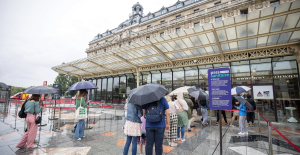The industrialist Émile Étienne Guimet paid a lot for the invitation. He had given his latest discovery the - albeit sparse - clothing and jewelry, placed value on a handpicked audience and is said to have even advised her to give her a stage name. Because "Margaretha Geertruida Zelle-MacLeod" would hardly have fitted the style of the performance. But it was "Mata Hari" who on March 13, 1905 in the Parisian Guimet Museum drove the guests crazy by dropping almost all their covers.
Born in 1876, the daughter of a hat maker in Leeuwarden, the Netherlands, she was willing to pay for social advancement with her most important asset, her body. In 1895 she went to the Dutch East Indies (Indonesia) with Colonial Officer Campbell Rudolf John MacLeod. From her impressions and her southern complexion, which she owed to her mother's Javanese roots, she created the artificial figure of an Indian dancer whose central message was a sultry, overwhelming eroticism.
After her return and her divorce, she perfected the art of erotic undressing with her “dance of the veil” and turned it into a highly lucrative business model. "She sways beneath the veils that simultaneously envelop and reveal her... Her breasts heave languidly, her eyes gleam with tears," wrote one languid critic. “Her secular dance is a prayer; lust becomes worship.”
She immediately became the star of the bourgeoisie and bohème. In the frivolous milieu of Paris, Madrid, Vienna and Berlin, Mata Hari set new standards, not only on the stage but also in the beds of men who had enough money. Because her lifestyle was in no way inferior to her greed for attention. She always suffered from money worries.
Her celebrated role model had also prompted numerous imitators onto the scene, who delighted the relevant establishments of the fin de siècle with ever more daring depictions. In addition, the selection of economically powerful admirers decreased significantly after the outbreak of war in 1914.
Therefore, in 1915, the offer of the German military intelligence service to scout out clues to new offensive plans of the Entente in return for a corresponding fee in the rear of the front was quite right for her. But Mata Hari's penchant for neat men in uniform aroused the suspicions of French military espionage. In Paris, a trap was set for "Agent H 21". Sentenced to death as a spy in summary proceedings in July 1917, she was shot dead in Vincennes near Paris on October 15. She was 41 years old.
It was probably clear to everyone involved that Mata Hari had not passed on any substantial information. But her male judges found her a prominent scapegoat whose sentencing could divert attention from the numerous mutinies that shook the French army in the spring of 1917.
You can also find "World History" on Facebook. We are happy about a like.
This article was first published in March 2021.

 B:SM will break its investment record this year with 62 million euros
B:SM will break its investment record this year with 62 million euros War in Ukraine: when kyiv attacks Russia with inflatable balloons loaded with explosives
War in Ukraine: when kyiv attacks Russia with inflatable balloons loaded with explosives United States: divided on the question of presidential immunity, the Supreme Court offers respite to Trump
United States: divided on the question of presidential immunity, the Supreme Court offers respite to Trump Maurizio Molinari: “the Scurati affair, a European injury”
Maurizio Molinari: “the Scurati affair, a European injury” Irritable bowel syndrome: the effectiveness of low-carbohydrate diets is confirmed
Irritable bowel syndrome: the effectiveness of low-carbohydrate diets is confirmed Beware of the three main sources of poisoning in children
Beware of the three main sources of poisoning in children First three cases of “native” cholera confirmed in Mayotte
First three cases of “native” cholera confirmed in Mayotte Meningitis: compulsory vaccination for babies will be extended in 2025
Meningitis: compulsory vaccination for babies will be extended in 2025 Thanks to intelligent cameras, RATP will indicate the least crowded trains on line 14
Thanks to intelligent cameras, RATP will indicate the least crowded trains on line 14 Dubai begins the transformation of Al-Maktoum to make it the future “largest airport in the world”
Dubai begins the transformation of Al-Maktoum to make it the future “largest airport in the world” When traveling abroad, money is a source of stress for seven out of ten French people
When traveling abroad, money is a source of stress for seven out of ten French people Elon Musk arrives in China to negotiate data transfer and deployment of Tesla autopilot
Elon Musk arrives in China to negotiate data transfer and deployment of Tesla autopilot Two people arrested for attempted damage to classified property at the Musée d’Orsay
Two people arrested for attempted damage to classified property at the Musée d’Orsay Death of composer Jean Musy, at 76, author of the music of Papy fait de la resistance, Les Champs-Élysées
Death of composer Jean Musy, at 76, author of the music of Papy fait de la resistance, Les Champs-Élysées Fanny Ardant prodigious in The Wound and the Thirst
Fanny Ardant prodigious in The Wound and the Thirst Hospitalized for pneumonia, Véronique Sanson cancels her concert in Nantes
Hospitalized for pneumonia, Véronique Sanson cancels her concert in Nantes Skoda Kodiaq 2024: a 'beast' plug-in hybrid SUV
Skoda Kodiaq 2024: a 'beast' plug-in hybrid SUV Tesla launches a new Model Y with 600 km of autonomy at a "more accessible price"
Tesla launches a new Model Y with 600 km of autonomy at a "more accessible price" The 10 best-selling cars in March 2024 in Spain: sales fall due to Easter
The 10 best-selling cars in March 2024 in Spain: sales fall due to Easter A private jet company buys more than 100 flying cars
A private jet company buys more than 100 flying cars This is how housing prices have changed in Spain in the last decade
This is how housing prices have changed in Spain in the last decade The home mortgage firm drops 10% in January and interest soars to 3.46%
The home mortgage firm drops 10% in January and interest soars to 3.46% The jewel of the Rocío de Nagüeles urbanization: a dream villa in Marbella
The jewel of the Rocío de Nagüeles urbanization: a dream villa in Marbella Rental prices grow by 7.3% in February: where does it go up and where does it go down?
Rental prices grow by 7.3% in February: where does it go up and where does it go down? Europeans: a senior official on the National Rally list
Europeans: a senior official on the National Rally list Blockade of Sciences Po: the right denounces a “drift”, the government charges the rebels
Blockade of Sciences Po: the right denounces a “drift”, the government charges the rebels Even on a mission for NATO, the Charles-de-Gaulle remains under French control, Lecornu responds to Mélenchon
Even on a mission for NATO, the Charles-de-Gaulle remains under French control, Lecornu responds to Mélenchon “Deadly Europe”, “economic decline”, immigration… What to remember from Emmanuel Macron’s speech at the Sorbonne
“Deadly Europe”, “economic decline”, immigration… What to remember from Emmanuel Macron’s speech at the Sorbonne These French cities that will boycott the World Cup in Qatar
These French cities that will boycott the World Cup in Qatar Mercato: Fonseca coach of AC Milan? The Lille coach speaks
Mercato: Fonseca coach of AC Milan? The Lille coach speaks Ligue 1: OM with a three-way defense, Lens changes almost nothing
Ligue 1: OM with a three-way defense, Lens changes almost nothing Ligue 1: PSG officially crowned champion of France for the 12th time
Ligue 1: PSG officially crowned champion of France for the 12th time Ligue 1: Lyon offers Monaco and gets closer to a European place
Ligue 1: Lyon offers Monaco and gets closer to a European place

















